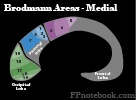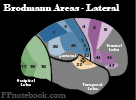Temporal Lobe, Temporal Lobe Function, Cerebral Temporal Lobe, Wernicke's Area, Brodmann Area 22, Auditory Area, Brodmann Area 41 and 42, Brodmann Areas of Temporal Lobe, Inferior Temporal Gyrus, Middle Temporal Gyrus, Superior Temporal Gyrus
- Definitions
- Temporal Lobe
- Key to longterm visual memories, as well as processing visual and auditory (including language) input
- Supports spontaneous speech, repetition, comprehension, writing and naming
- Lesions may result in behavior change and Memory Loss
- Wernicke's Area (area 22, in the dominant hemisphere) is key to understanding speech and language
- Optic Radiations from the superior Visual Fields also pass through the Temporal Lobes (Quadrantanopia)
- Anatomy
- Brodmann Areas of Temporal Lobe
- Images
- Wernicke's Area (Area 22)
- Dominant hemisphere lesions in Wernicke's Area result in Receptive Aphasia (auditory Aphasia)
- The patient does not understand speech (including their own speech)
- Auditory Area (Area 41, 42)
- Hearing typically has bilateral input and therefore a lesion affecting one side only may result in no deficit
- Hearing Deficits are typically distal to the exit of Cranial Nerve 8.
- History
- Findings of pathology (e.g. Tumor)
- Behavior change
- Autistic symptoms
- Memory Loss
- Exam
- Dominant or Standard Aphasia Testing (normal findings)
- Spontaneous speech
- Repetition
- Comprehension
- Writing
- Naming
- Exam
- Non-Dominant or Affect Interpretation (normal findings)
- Patient names affect in photo of faces or conveyed in examiner's voice
- Signs
- Brain Lesions
- Complex Partial Seizures or Generalized Seizures
- Quadrantanopia (Vision Loss or anopia in a Visual Field quadrant)
- Behavioral alterations
- Receptive Aphasia (dominant hemisphere, Area 22)

